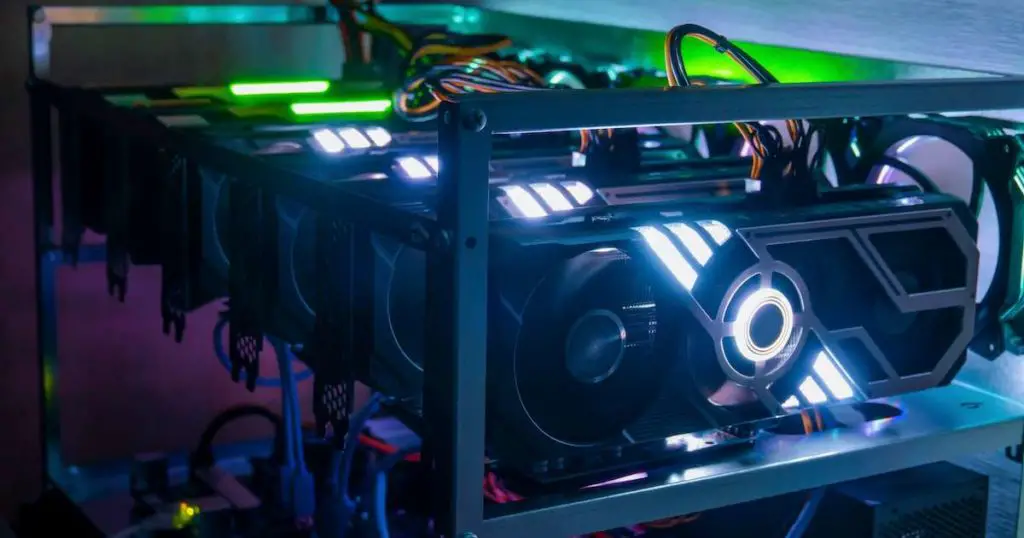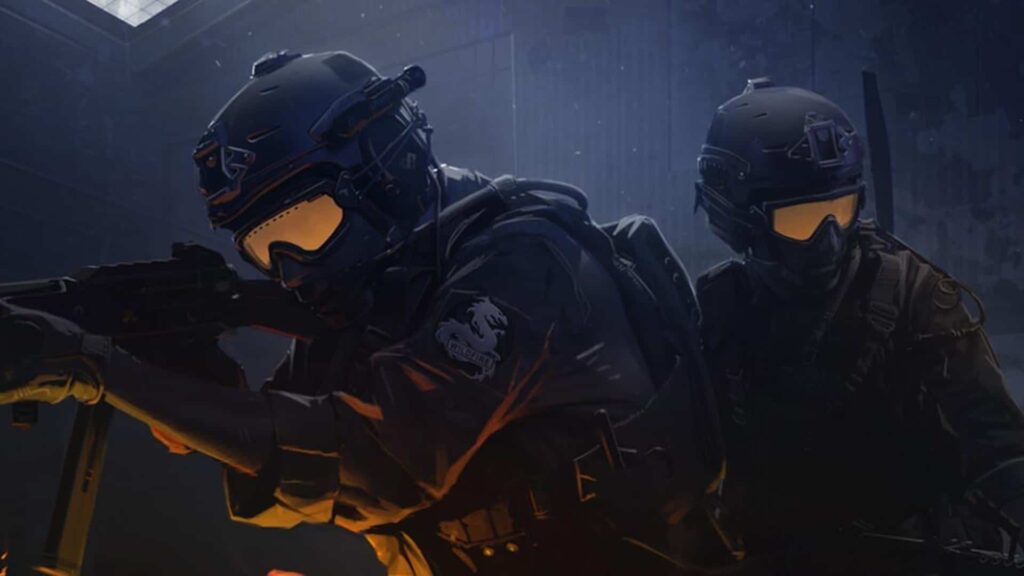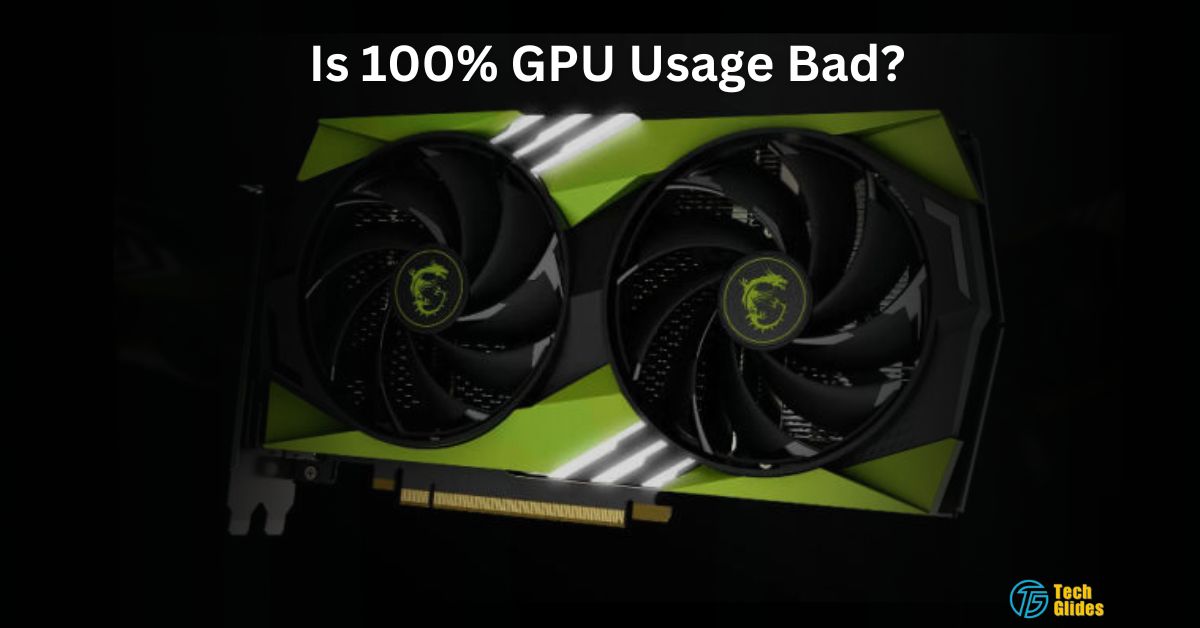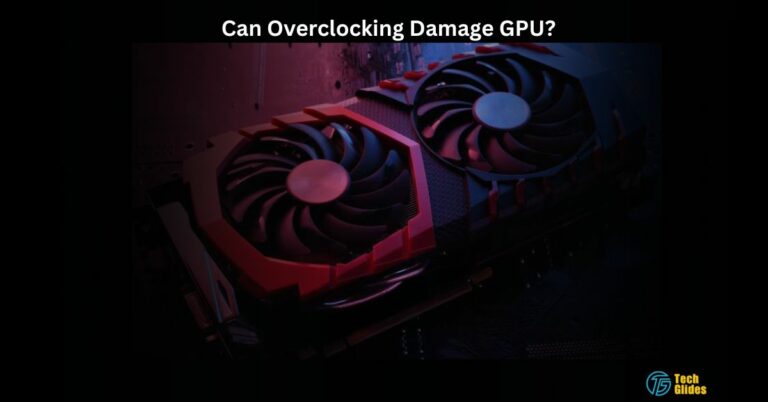Is 100% GPU Usage Bad? – Click To Know Details!
As technology continues to advance, we find ourselves pushing the boundaries of our computing devices more than ever before. Whether it’s immersive gaming experiences, demanding graphic design projects, or complex data processing tasks, our reliance on GPUs (Graphics Processing Units) has grown substantially. However, with this increased reliance comes a question that often arises among users: Is 100% GPU usage bad?
No, it’s not bad if your GPU is at 100%. It means it’s working hard, which is normal for tasks like gaming. But if it stays maxed out for a long time, it could make your computer hot and might wear out the GPU faster if it’s not cooled well.
Let’s uncover the nuances behind GPU utilization in detail together!
Contents
- What Is GPU? – You Should Clear This First!
- How Does GPU Work in a Laptop/Computer?
- Can I Have 100% GPU Usage? – Check If 100% GPU is Good or not!
- Is GPU Usage 100% Normal for Gamers?
- Is It Safe To Keep The GPU On 100% Utilization For A Very Long Time? – Attention!
- How much GPU utilization is bad? – See What is a good GPU usage Percentage?
- Why Is 100% GPU Usage Bad Sometimes? – Few Drawbacks!
- How Can We Fix Some Bad Impacts of GPU? – Just Try This!
- Does Your GPU Usage Spike to 100 Percent on Windows?
- How Hot Can a GPU Run Without Damage?
- Should I be worried if GPU usage is at 100%? I’m hitting 90% constantly on Warzone.
- Frequently Asked Questions
- 1. What is too hot for a GPU?
- 2. PSA: 100% GPU usage is ok, and you probably don’t need as much VRAM as task manager says.
- 3. Is it safe to run GPU 24/7?
- 4. Is it possible to use my GPU to 100% of its capacity on a daily basis and expect to have it last 5+ years with proper maintenance?
- 5. Is 67-70°C a good GPU temperature on 100% usage?
- 6. My GPU utilization is usually around 97% at around 80 degrees (C). Is this safe for my GPU?
- 7. Can a GPU last for 10 years?
- Conclusion Of The Discussion:
- Also Read:
What Is GPU? – You Should Clear This First!
Before we delve into the details, let’s take an analysis of the factor that actually is GPU. Basically, A Graphics Processing Unit (GPU) is a specialized electronic circuit designed to rapidly manipulate and alter memory to accelerate the creation of images in a frame buffer intended for output to a display device.
In simpler terms, it’s the component responsible for rendering graphics on your computer or laptop screen. GPUs come in various forms, from integrated graphics processors found in CPUs to dedicated discrete graphics cards.
Also Read: Can An iPad Charger Charge A MacBook Air? – 2024 Guide!
What Is the Purpose of GPU?
The primary purpose of a GPU is to offload graphics processing tasks from the central processing unit (CPU). By doing so, it allows for faster rendering of images, smoother gameplay in video games, and quicker processing of graphics-intensive applications such as video editing and 3D modelling software.
Must Check: Can You Charge A Macbook With 2 Chargers? – Safety Guide!
How Does the GPU Affect Our Laptop or Computer?
The impact of the GPU on your laptop or computer is significant, especially in tasks that require intensive graphical processing. Here’s how:
1. Graphics Performance:
One of the most noticeable effects of a GPU is on graphics performance. A powerful GPU can handle complex visual tasks with ease, delivering smooth and detailed images in games, videos, and graphic design applications.
2. Multitasking:
GPUs can also contribute to multitasking capabilities. With a dedicated GPU, your computer can handle multiple graphics-intensive tasks simultaneously without experiencing significant slowdowns or performance issues.
3. Energy Efficiency:
Modern GPUs are designed to be energy-efficient, balancing performance with power consumption. This ensures that your laptop or computer can deliver high graphics performance without draining the battery excessively or overheating the system.
4. Machine Learning and AI:
In addition to graphics rendering, GPUs are increasingly used for general-purpose computing tasks, including machine learning and artificial intelligence. Their parallel processing capabilities make them well-suited for training neural networks and executing complex algorithms efficiently.
5. External Displays:
For users who require multiple displays or high-resolution monitors, a GPU plays a crucial role in driving these external displays. Whether it’s for gaming, productivity, or content creation, a capable GPU ensures smooth performance across all connected screens.
You have to Read: Is It Bad To Use Your Laptop While Charging? – 2024 Solutions Here!

How Does GPU Work in a Laptop/Computer?
The GPU processes and renders graphics on your device, converting data into images displayed on your screen by rapidly performing complex calculations.
Basically, GPUs, or Graphics Processing Units, work by executing thousands of smaller tasks simultaneously, a process known as parallel computing. They have specialized cores designed specifically for rendering images quickly and efficiently. In laptops and computers, the GPU receives data from the CPU and converts it into images, which are then displayed on the screen. This enables smooth graphics performance in tasks such as gaming, video playback, and graphic design.
Do You Know? Why Won’t My Laptop Charge? – All That You Seek!
Can I Have 100% GPU Usage? – Check If 100% GPU is Good or not!
Yes, you can have 100% GPU usage, especially during demanding tasks like gaming or video editing. However, sustained high GPU usage may lead to increased heat generation and potential performance issues if not properly managed.
100% GPU usage indicates that your GPU is fully utilized, which is common during tasks that require intensive graphics processing, such as gaming or video editing. While it’s normal for the GPU to reach maximum usage during these tasks, prolonged periods of high usage can lead to increased heat generation, potentially causing thermal throttling and impacting performance. Therefore, it’s essential to monitor temperatures and ensure adequate cooling to prevent overheating and maintain optimal GPU performance.
Take Analysis To: Does Acer Nitro 5 Support USB-C Charging? – Find Out In 2024!
Is GPU Usage 100% Normal for Gamers?
Yes, it’s normal for GPU usage to reach 100% during gaming sessions, especially in graphically demanding games. This indicates that the GPU is working hard to render graphics smoothly and provide an immersive gaming experience.
Gamers often push their hardware to its limits to achieve high frame rates and visual fidelity in games. As a result, it’s common for the GPU to operate at maximum capacity during gaming sessions, ensuring smooth gameplay and vibrant graphics. However, while 100% GPU usage during gaming is normal, it’s essential to monitor temperatures and ensure adequate cooling to prevent overheating and maintain optimal performance.
Never Miss: Can Overclocking Damage GPU? – Yes Or No!

Is It Safe To Keep The GPU On 100% Utilization For A Very Long Time? – Attention!
No, it is not safe enough. Keeping the GPU at 100% utilization for extended periods may lead to increased heat generation, potentially impacting its longevity if it is not properly cooled.
While GPUs are designed to handle heavy workloads, prolonged periods of 100% utilization can result in increased heat generation, potentially causing thermal throttling and impacting performance. Over time, excessive heat buildup can also affect the longevity of the GPU, leading to potential hardware issues. Therefore, it’s essential to monitor temperatures and ensure proper airflow and cooling to prevent overheating and maintain the GPU’s health and performance over time.
Recent Post: What Is Aafp On The Motherboard – Do You Know!
How much GPU utilization is bad? – See What is a good GPU usage Percentage?
There isn’t a specific threshold for “bad” GPU utilization, as it varies depending on the task and hardware. The ideal GPU usage percentage depends on the specific task and hardware configuration.
In general, high GPU usage near 100% during tasks like gaming, video editing, or rendering indicates efficient utilization of the GPU’s capabilities. It signifies that the GPU is fully engaged and effectively processing the workload. Conversely, consistently low GPU usage, such as below 30%, may indicate inefficient resource allocation or bottlenecks elsewhere in the system, potentially hindering performance. Therefore, rather than focusing solely on a specific percentage, it’s essential to consider the context and performance requirements of the task at hand when evaluating GPU utilization.
Interesting Fact: How To Check What Motherboard I Have – Heart Of Your System!
Is 99 percent GPU usage bad?
No, 99% GPU usage isn’t inherently bad. It typically indicates efficient utilization of the GPU’s capabilities, especially during demanding tasks like gaming or rendering.
However, prolonged periods of near-maximum GPU usage may lead to increased heat generation and potential performance issues if not adequately cooled. GPU usage reaching 99% during intensive tasks is normal and often desirable, as it suggests that the GPU is fully engaged in processing the workload efficiently. However, it’s essential to monitor temperatures and ensure adequate cooling to prevent overheating and potential performance degradation. While 99% GPU usage isn’t inherently problematic, it’s crucial to consider factors such as temperature management and overall system stability to maintain optimal performance.
Take Analysis To: Geekzilla.Tech Honor Magic 5 Pro – Tech Brilliance!
Is 30% GPU usage bad?
Not necessarily. Low GPU usage, like 30%, isn’t always bad. It might mean the task doesn’t need much graphics power, or there could be other things slowing down your computer.
If your GPU is only working at 30%, it could be because the task you’re doing doesn’t need a lot of graphics processing. For example, just browsing the internet or writing documents doesn’t require much from the GPU. Also, there could be other parts of your computer, like the CPU, that are causing slowdowns instead of the GPU. So, while low GPU usage might seem like a problem, it’s not always something to worry about.
Do You Know? DigitalNewsAlerts – Your Instant Gateway To Current Affairs And Laptop Updates!
Why Is 100% GPU Usage Bad Sometimes? – Few Drawbacks!
Demanding Tasks:
Firstly, when you’re doing tasks that need a lot of graphics power, like playing games or editing videos, your GPU might work really hard. This can make it get hot, which might cause it to slow down or even break if it’s not cooled properly.
Intensive 3D Rendering:
Additionally, when you’re doing things like making 3D animations or simulations, your GPU has to work at full speed for a long time. This can put a lot of strain on it and might make it wear out faster if it doesn’t have good cooling.
Malware or Background Processes:
Moreover, if your computer has malware or unnecessary programs running in the background, it can use up GPU power for no reason. Getting rid of these can help reduce the strain on your GPU.
Driver Problems:
Furthermore, if your GPU drivers are old or not working right, your GPU might act strangely, like suddenly hitting 100% usage for no apparent reason. Updating your drivers can often fix this issue.
Bad Software:
Additionally, poorly made or buggy software can also make your GPU work harder than it needs to. Keeping your software up to date can help prevent this from happening.
Graphics Settings:
Moreover, if your game or program has graphics settings set too high for your computer to handle, your GPU might work harder than necessary. Lowering these settings can help ease the strain on your GPU without sacrificing too much visual quality.
Broken Hardware:
Also, if your GPU or other parts of your computer are broken, it might cause your GPU to work harder than normal. Fixing or replacing these parts can help solve the problem.
Mining Cryptocurrency:
Furthermore, if you’re using your GPU for cryptocurrency mining, it might run at 100% for a long time. This can put a lot of stress on your GPU and might make it wear out faster.
Virtual Reality (VR) Gaming:
Lastly, when you’re playing VR games, your GPU has to work really hard to make the game look good and run smoothly. While this is normal, it’s important to make sure your computer stays cool to avoid any problems.
Don’t Miss Out: Qxefv- 2024 Laptop Performance Optimization!
How Can We Fix Some Bad Impacts of GPU? – Just Try This!
- Keep your GPU cool by cleaning out dust from fans and vents, and consider adding extra cooling like fans or liquid coolers.
- Update your GPU drivers regularly to make sure they work well with the latest software.
- Adjust graphics settings in games and apps to ease the load on your GPU.
- Close unnecessary programs running in the background to free up resources for your GPU.
- Watch your GPU’s temperature and make sure it doesn’t get too hot using monitoring tools.
- Think about upgrading your hardware if your current GPU struggles with tasks like adding more RAM or getting a more powerful GPU.
- Regularly clean your computer’s insides and make sure it has good airflow to prevent overheating and keep performance smooth.
Also Check: Can I Charge My Phone With Type C Laptop Charger? – Step By Step Explanation!
Does Your GPU Usage Spike to 100 Percent on Windows?
Yes, it’s possible for GPU usage to spike to 100% on Windows, especially during demanding tasks like gaming or video editing. However, continually using high GPU usage may indicate potential issues with software optimization, drivers, or hardware limitations.
Windows users may observe occasional spikes in GPU usage to 100% during intensive tasks, which is generally normal. However, if the GPU consistently operates at maximum capacity without significant load fluctuations, it could signal underlying problems such as inefficient software utilization or hardware limitations. Monitoring GPU usage and investigating potential causes can help identify and address any issues affecting performance.
How Hot Can a GPU Run Without Damage?
Most GPUs can safely operate up to temperatures of around 90-95°C without sustaining damage. But exposure to temperatures above this range may lead to performance degradation and potential hardware failures over time.
While GPUs are engineered to endure elevated temperatures, consistent exposure to excessive heat can still jeopardize their longevity and operational efficiency. Therefore, it’s imperative to consistently monitor temperatures and implement effective cooling solutions to prevent overheating. By ensuring that temperatures remain below 90-95°C, particularly during intensive computing sessions, you can help extend the lifespan of your GPU and maintain consistent performance.
Related Post: Do All HP Laptops Use The Same Charger? – Let’s Explore Differences In 2024!
Should I be worried if GPU usage is at 100%? I’m hitting 90% constantly on Warzone.
As I have mentioned above so many times, Consistent GPU usage of around 90% in games like Warzone is normal and indicates efficient utilization. However, it’s essential to monitor temperatures to prevent overheating and ensure proper cooling for optimal performance and longevity.
In graphically demanding games like Warzone, GPU usage around 90% is typical and suggests that your GPU is working hard to render graphics smoothly. While reaching 100% usage occasionally is not a cause for concern, consistently high usage may warrant monitoring temperatures to prevent overheating. Ensuring adequate cooling and maintaining temperatures within safe limits can help optimize GPU performance and prevent potential hardware damage.
Frequently Asked Questions
1. What is too hot for a GPU?
Temperatures above 90-105°C are considered too hot for a GPU and may lead to performance degradation and potential hardware failures over time. Therefore, it’s essential to ensure that temperatures stay below the 90-95°C threshold to maintain optimal performance and longevity.
2. PSA: 100% GPU usage is ok, and you probably don’t need as much VRAM as task manager says.
Yes, 100% GPU usage is generally okay, especially during demanding tasks like gaming or rendering. Additionally, the VRAM usage reported by the Task Manager may not accurately reflect the actual VRAM requirements of your applications. It’s normal for your GPU to reach 100% usage during intensive tasks, indicating efficient utilization of its capabilities. Moreover, Task Manager’s VRAM reporting may not always be accurate, so it’s essential to consider the specific requirements of your applications rather than relying solely on Task Manager’s data.
3. Is it safe to run GPU 24/7?
Running a GPU 24/7 can potentially accelerate wear and tear, leading to reduced lifespan and increased risk of hardware failures. Continuous operation places constant stress on the GPU, which can contribute to accelerated degradation over time.
4. Is it possible to use my GPU to 100% of its capacity on a daily basis and expect to have it last 5+ years with proper maintenance?
Using the GPU at 100% capacity daily, coupled with proper maintenance and cooling, can help extend its lifespan but may not guarantee longevity beyond 5 years due to various factors such as workload intensity and hardware reliability.
5. Is 67-70°C a good GPU temperature on 100% usage?
A GPU temperature of 67-70°C under 100% usage is generally considered acceptable and falls within the safe operating range for most GPUs.
Maintaining temperatures below 70°C, particularly under heavy load, helps ensure optimal performance and prevents overheating-related issues. Therefore, a temperature range of 67-70°C is typically considered satisfactory for GPU operation.
6. My GPU utilization is usually around 97% at around 80 degrees (C). Is this safe for my GPU?
While a GPU utilization of 97% and temperatures around 80°C are elevated, they generally fall within acceptable limits for most GPUs. However, it’s crucial to monitor temperatures and ensure proper cooling to prevent overheating-related issues.
7. Can a GPU last for 10 years?
While some GPUs may last for 10 years or more with proper maintenance and usage, longevity can vary depending on factors such as workload intensity, environmental conditions, and hardware quality.
Conclusion Of The Discussion:
Yes, 100% GPU usage can be considered bad if it occurs consistently over long periods, as it may lead to increased heat generation, potential performance issues, and accelerated wear on the GPU.
So make sure you aren’t using it at that level for a long period. Try the cautions We have provided above and see how amazingly you can take advantage of GPU at its maximum capacity without ruining its lifespan.


